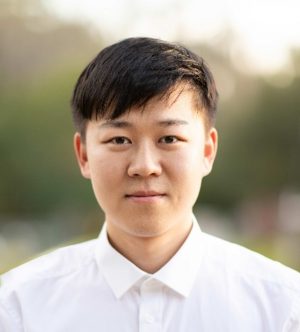List of Seminar Presentations
| Fall 2023 | Shehab Shousha
Department of Nuclear Engineering, North Carolina State University |
Title: Unveiling nuclear materials at the atomic scale: Insights and challenges through density functional theory | Link |
| Yixi Shen
Department of Mechanical and Aerospace Engineering, University of Florida |
Title: Migration Velocities of Intergranular He Gas Bubbles Under Thermal Gradients in Fe by Phase-Field Modeling | Link | |
| Md Ali Muntaha
Department of Materials Science and Engineering, University of Florida |
Title: Investigating the impact of Intergranular Bubble Evolution on Fission Gas Release in UO2?using a Hybrid Phase-Field/Cluster Dynamics Model | Link |
Fall 2023
Unveiling nuclear materials at the atomic scale: Insights and challenges through density functional theory
Shehab Shousha
Abstract
Atomistic modeling techniques play a crucial role in nuclear materials research, providing valuable insights into the behavior, properties, and performance of materials used in nuclear applications. By simulating and analyzing the behavior of individual atoms and molecules, atomistic modeling techniques contribute to a deeper understanding of nuclear materials at the atomic scale. Among these techniques, density functional theory (DFT) has been widely used to investigate nuclear materials’ electronic structure and thermophysical properties from first principles. DFT stands out for its unparalleled accuracy in calculating quantities such as the electronic band structure, electronic densities of states, and point defects formation and migration energies. This talk will discuss the modeling of the U-Zr metallic fuels using DFT and the challenges in understanding these systems.
Email address: smshoush@ncsu.edu
Biography
Shehab Shousha is a Ph.D. student in the Department of Nuclear Engineering at NCSU. He is a member of the computational nuclear materials science group. His research focus is atomic scale modeling of nuclear fuels. Before joining Dr. Benjamin Beeler?s group, he worked as a research assistant in the materials theory group at the American University in Cairo. He obtained his B.Sc. and M.Sc. degrees in nuclear and radiation engineering from Alexandria University in Egypt.
Migration Velocities of Intergranular He Gas Bubbles Under Thermal Gradients in Fe by Phase-Field Modeling
Dr. Yixi Shen
Abstract
We compute the migration velocity of intergranular He bubbles in Fe under thermal gradients using phase-field (PF) modeling. Grain boundaries (GBs) with energies in the range of 0.88 ? 1.6 J/m^2 are considered. To develop a suitable PF model, the influences of the PF parameterization strategy, thermal conductivity in grain boundaries, and GB diffusion coefficients on intergranular He bubble geometry are addressed. Good agreement between our simulations and a theoretical model are found for the contact angle at the junction of the bubble and GB. Under the application of a thermal gradient, we find that intergranular He bubbles migrate slower than He bubbles in an Fe matrix. We show that this is a result of the smaller temperature gradient at the bubble/GB junction when the bubble is at the GB, than when the bubble is in the matrix. A linear relationship between bubble migration velocity and temperature gradient is observed for intergranular He bubbles for all GB energies studied in this work, consistent with predictions from a theoretical model. Intergranular bubble migration velocity is also found to depend linearly on the inverse of bubble size. However, we find the shape of the bubble influences intergranular bubble migration velocity. An analytical model for bubble migration velocity that considers the shape of an intergranular bubble is proposed and shown to capture the computed PF data for He bubbles.
Email address: yixishen@ucsb.edu
Biography
Yixi Shen was born and raised in Wuhan, China. He attended the Wuhan Institute of Technology from 2011 to 2015 to obtain a bachelor?s degree in mechanical engineering. He then enrolled in the Master of Science (M.S.) program in the Department of Mechanical and Aerospace Engineering at the University of Florida. After graduating from the M.S. program in May 2018, he started his doctoral studies in mechanical engineering under the advisement of Prof. Douglas E. Spearot at UF. His Ph.D. project focuses on multiscale modeling of evolution and motion of defects in metallic material.? He defended his Ph.D. dissertation in August 2023 and will be joining Dr. Irene Beyerlein?s research group as a postdoctoral associate at UCSB in Oct 2023.
August 29th, 2023 Seminar Presenter

Md Ali Muntaha
Department of Materials Science and Engineering, University of Florida
Investigating the impact of Intergranular Bubble Evolution on Fission Gas Release in UO2?using a Hybrid Phase-Field/Cluster Dynamics Model
Md Ali Muntahaa,?, Sourav Chatterjeea, Sophie Blondelb, Larry Aagesenc, David Anderssond, Brian D. Wirthb,e, Michael R. Tonksa
Affiliation
a: Department of Materials Science and Engineering, University of Florida, Gainesville, FL 32611, USA
b: Department of Nuclear Engineering, University of Tennessee, Knoxville, TN, 37996, USA
c: Computational Mechanics and Materials, Idaho National Laboratory, Idaho Falls, ID 83415, USA
d: MST-8, Los Alamos National Laboratory, Los Alamos, NM, 87545, USA
e: Oak Ridge National Laboratory, Oak Ridge, TN, 37830, USA
Abstract
Fission gas bubble evolution and fission gas release have a significant impact on light water reactor fuel performance, but it has never been observed in situ. Modeling and simulation provide a means to investigate fission gas bubble evolution under reactor conditions. In this work, we apply a hybrid phase field/cluster dynamics model to simulate fission gas bubble evolution in UO2 during reactor operation. We first use 2D simulations to investigate the impact of fast GB and surface diffusion. We find that the GB diffusivity directly impacts the rate of gas release via GB transport, and that the GB diffusivity is likely below 104?times the lower value from Olander and van Uffelen (2001). We also find that the surface diffusivity impacts bubble coalescence and mobility, and that the bubble surface diffusivity is likely below 10?4?times the value from Zhou and Olander (1984). We then take what we learn from the 2D simulations and extend our study to 3D, focusing on morphological evolution of intergranular bubbles along GBs and triple junctions (TJs). We simulate 10-grain and 100-grain polycrystalline microstructures including, to our knowledge, the largest mesoscale simulations of fission gas bubble evolution that have been carried out. Our findings show that there is a tight coupling between fission gas bubble evolution and grain boundary migration and that fission gas release can result in the collapse of interconnected bubble networks.
?Corresponding author;?Email address:?md.muntaha@ufl.edu?(Md Ali Muntaha)
Biography
Md Ali Muntaha earned his Bachelor of Science degree in Mechanical Engineering from the Bangladesh University of Engineering and Technology. He then joined Dr. Michael Tonks’s research group in 2018 as a Ph.D. student, furthering his studies in the Materials Science and Engineering Department at the University of Florida. His research primarily involves the investigation of microstructure evolution in materials, utilizing the phase-field approach. He defended his Ph.D. dissertation in August 2023 and will be joining Dr. Janelle Wharry?s research group as a postdoctoral associate at Purdue University in West Lafayette, IN, in September 2023, with the aim of bridging the gap between experimental and computational work.


